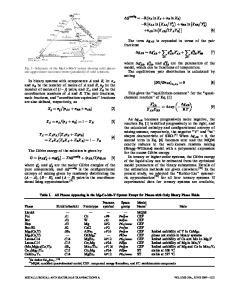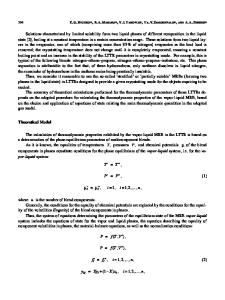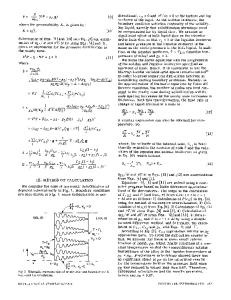Development of Thermodynamic Description of a Pseudo-Ternary System for Multicomponent Ti64 Alloy
- PDF / 329,558 Bytes
- 6 Pages / 593.972 x 792 pts Page_size
- 11 Downloads / 292 Views
Basic and Applied Research: Section I
Development of Thermodynamic Description of a Pseudo-Ternary System for Multicomponent Ti64 Alloy F. Zhang, S.-L. Chen, Y.A. Chang, N. Ma and Y. Wang
(Submitted October 13, 2006) A method is presented to obtain a thermodynamic description of a multicomponent alloy system in terms of a pseudo-ternary formalism. In the present study, this method was applied to multicomponent Ti64 alloys with the ‘‘6’’ and ‘‘4’’ denoting the nominal 6 wt.% of Al and 4 wt.% of V in this class of Ti alloys. However these alloys, in practice, contain many other alloying elements such as O, C N, Fe, and H which exhibit appreciable effect on the thermodynamic properties of Ti64. The essence of this approach is to treat the multicomponent alloys as a pseudo-ternary Ti-Alx-Vy, in which the apparent composition of Alx is the weighted summation of that of Al and those of the a-stabilizers in minor quantities such as O, C and N and that of Vy is the weighted summation of that of V and those of the b stabilizing minor elements such as Fe and H. Three Ti64 alloys with slightly different chemistries were treated as pseudo-ternary alloys, and the b transus and b (and a) approach curves were calculated using this pseudo-ternary thermodynamic description. The calculated results were found to compare favorably with those calculated from a multicomponent thermodynamic database for titanium alloys. This study demonstrates that such a simplified thermodynamic description, when available, can be readily coupled with kinetic models for engineering applications. One example is to predict microstructure evolution of a multicomponent alloy when subjected to a specific heat treatment condition.
Keywords
CALPHAD, phase diagram, Phase-Field modeling
1. Introduction It is well-known that the mechanical properties of an alloy depend on its microstructure, which is determined by the alloy chemistry, heat treatment, and processing conditions. If the correlation between them can be well-established, the desired microstructure and mechanical properties can be achieved through the optimization of alloy chemistry and processing conditions. However, establishing such a correlation is not This article was presented at the Multi-Component Alloy Thermodynamics Symposium sponsored by the Alloy Phase Committee of the joint EMPMD/SMD of The Minerals, Metals, and Materials Society (TMS), held in San Antonio, Texas, March 12-16, 2006, to honor the 2006 William Hume-Rothery Award recipient, Professor W. Alan Oates of the University of Salford, UK. The symposium was organized by Y. Austin Chang of the University of Wisconsin, Madison, WI, Patrice Turchi of the Lawrence Livermore National Laboratory, Livermore, CA, and Rainer Schmid-Fetzer of the Technische Universitat Clausthal, Clauthal-Zellerfeld, Germany. F. Zhang, and S.-L. Chen, CompuTherm, LLC, 437 S. Yellowstone Dr., Ste. 217, Madison, WI 53719; Y.A. Chang, Department of Materials Science & Engineering, University of Wisconsin-Madison, 1509 University Ave., Madison, WI 53706; and N. Ma
Data Loading...











